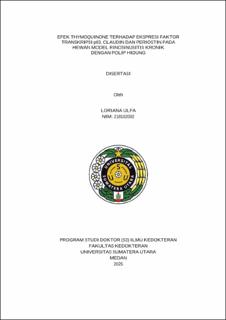Efek Thymoquinone terhadap Ekspresi Faktor Transkripsi p63, Claudin dan Periostin pada Hewan Model Rinosinusitis Kronik dengan Polip Hidung
Effect of Thymoquinone on the Expression of Transcription Factors p63, Claudin and Periostin in Animal Model of Chronic Rhinosinusitis with Nasal Polyps

Date
2025Author
Ulfa, Loriana
Advisor(s)
Munir, Delfitri
Rambe, Andrina Yunita Murni
Farhat, Farhat
Metadata
Show full item recordAbstract
Introduction: Chronic rhinosinusitis with nasal polyps (CRSwNP) is a chronic condition of the nasal mucosa and paranasal sinuses, involving epithelial barrier dysfunction, chronic inflammation, and tissue remodeling. Tight junction proteins such as claudin, and transcription factor p63, are important in maintaining epithelial integrity, while periostin is involved in remodeling through the TGF-ß pathway. Thymoquinone (TQ) from Nigella sativa (NS) is known to have anti-inflammatory effects, but its effect on CRSwNP has not been widely studied.
Objective: To determine the effect of TQ on CRSwNP from histopathological analysis of animal model sinonasal tissue, the expression of transcription factors p63, claudin and periostin in animal models of CRSwNP.
Methods: This study is an experimental study with a Posttest Only Control Group design, using Wistar rats (Rattus norvegicus, sp) as a model of CRSwNP. The rats were divided into three groups: normal control, negative control and positive control. The normal control group was given Phosphate Buffer Saline (PBS), the negative control was induced by ovalbumin (OVA) and Staphylococcus aureus enterotoxin B (SEB), the positive control was induced by OVA and SEB and given TQ therapy. Induction was carried out for 13 weeks, followed by histopathological analysis, immunohistochemistry to assess the expression of p63 and claudin transcription factors and RT-qPCR to assess periostin expression.
Results: Histopathology showed that the negative control group had a polyp structure with thickening of the basement membrane and inflammatory cell infiltration, while the positive control group showed reduced stromal edema and no polyps were found. p63 expression increased significantly in the negative control group, but decreased significantly in the positive group, while claudin expression increased significantly. Periostin mRNA expression increased significantly in the negative control, but decreased in the positive control group.
Conclusion: Thymoquinone has the potential to be an effective additional therapy for CRSwNP, as assessed by histopathological mucosal repair, decreased expression of p63 transcription factor, increased claudin expression and decreased periostin which together can reduce inflammation and remodeling in CRSwNP.
Collections
- Doctoral Dissertations [185]
